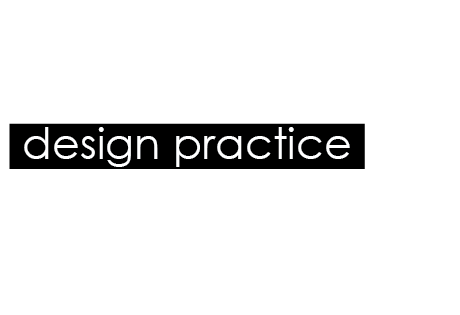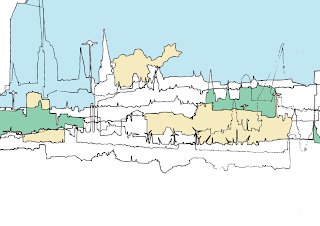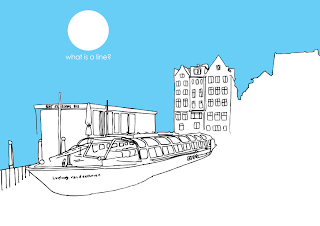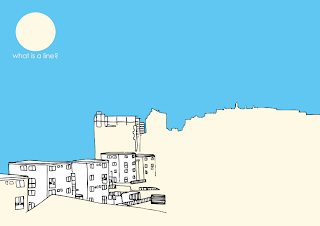Luke O'Brien Take it easy, and enjoy is the advice and the hardest thing is just the constant juggling of work! and that is the hardest part of the course! x
Kirsty Alderson The hardest thing is juggling different briefs all at once and keeping track of what you've get left to do. The best thing has been beginning to find my style and also the course has helped me gain confidence.The advice i'd give is not to get too stressed, work hard and don't take taught time for granted! x
Sophie Wilson i think the hardest part is absorbing so much new information in one go- as fred eloquently put "the course is like drowning...but by the third year you'll learn how to love drowning" haha...the best thing is the excitement you get from producing something that has a profound effect..and seeing your work go to print! :) my advice would be...plan, plan plan and for gods sake get some sleep xx
Sarah Pritchard The hardest part of the course is juggling all the different modules going off at once, and knowing which to prioritise without neglecting others too much. The best thing has to be the people, and how much I've actually learnt in such a short space of time. The advise I would be is to just keep on top of everything as it will make life easier days before module deadlines.
Baljeet Kaur Samra Hardest thing has been keeping up with the pace of the course and the best thing is everything I've learnt :) my advice would be don't be late. Ever.
Christoffel Van Niekerk hardest was being confident in my own work and getting use to all the briefs at once. Best thing about the course has been all the facilities and eddie cooper. My advice to the year one would be work hard and make mistakes.
Lisa Whitaker The hardest thing has been keepin the pace especially after getting absorbed with Collection 100 and the CTS essay, I found it really hard to motivate myself fot the next briefs. Best thing is the work ethic and the people. My advice is experiment and get absorbed in it all. x
Bethany Yates hardest thing was probably getting used to all the things going on at one, best thing is just the course and all the people on it - everything is so much fun. advice? try hard, make mistakes and laugh a lot
Charlie Crosby getting into the habit of thinking, doing and living design
the best thing is how much you do and learn it really does make you appreciate the £3296 you pay to come here (not sure if that number is correct)
i would say stay in the studios till late and then go home and relax once you've done your work and then go out.
Lisa Whitaker It is not essential to buy a Macbook in your first year x
Charlie Crosby getting into the habit of thinking, doing and living design
the best thing is how much you do and learn it really does make you appreciate the £3296 you pay to come here (not sure if that number is correct)
i would say stay in the studios till late and then go home and relax once you've done your work and then go out.
Lisa Whitaker It is not essential to buy a Macbook in your first year x
------------------------
The 10 Commandments - God's Revelation in the Old Testament
The 10 Commandments are found in the Bible's Old Testament at Exodus, Chapter 20. They were given directly by God to the people of Israel at Mount Sinai after He had delivered them from slavery in Egypt:
"And God spoke all these words, saying: 'I am the LORD your God…
ONE: 'You shall have no other gods before Me.'
TWO: 'You shall not make for yourself a carved image--any likeness of anything that is in heaven above, or that is in the earth beneath, or that is in the water under the earth.'
THREE: 'You shall not take the name of the LORD your God in vain.'
FOUR: 'Remember the Sabbath day, to keep it holy.'
FIVE: 'Honor your father and your mother.'
SIX: 'You shall not murder.'
SEVEN: 'You shall not commit adultery.'
EIGHT: 'You shall not steal.'
NINE: 'You shall not bear false witness against your neighbor.'
TEN: 'You shall not covet your neighbor's house; you shall not covet your neighbor's wife, nor his male servant, nor his female servant, nor his ox, nor his donkey, nor anything that is your neighbor's.'
The 10 Commandments are found in the Bible's Old Testament at Exodus, Chapter 20. They were given directly by God to the people of Israel at Mount Sinai after He had delivered them from slavery in Egypt:
"And God spoke all these words, saying: 'I am the LORD your God…
ONE: 'You shall have no other gods before Me.'
TWO: 'You shall not make for yourself a carved image--any likeness of anything that is in heaven above, or that is in the earth beneath, or that is in the water under the earth.'
THREE: 'You shall not take the name of the LORD your God in vain.'
FOUR: 'Remember the Sabbath day, to keep it holy.'
FIVE: 'Honor your father and your mother.'
SIX: 'You shall not murder.'
SEVEN: 'You shall not commit adultery.'
EIGHT: 'You shall not steal.'
NINE: 'You shall not bear false witness against your neighbor.'
TEN: 'You shall not covet your neighbor's house; you shall not covet your neighbor's wife, nor his male servant, nor his female servant, nor his ox, nor his donkey, nor anything that is your neighbor's.'
--------------------------
A black box: definition found on wikepedia.com
In aviation, a "black box" (they are actually bright orange, to facilitate their being found after a crash) is an audio recording device in the cockpit of an airplane or helicopter. It records the conversation of the pilots during a flight, so if something goes very wrong, investigators can use the black box recording to determine what happened. Although these devices were originally called black boxes for a different reason, they are also an example of a black box according to the meaning above, in that it is of no concern how the recording is actually made.






































































































